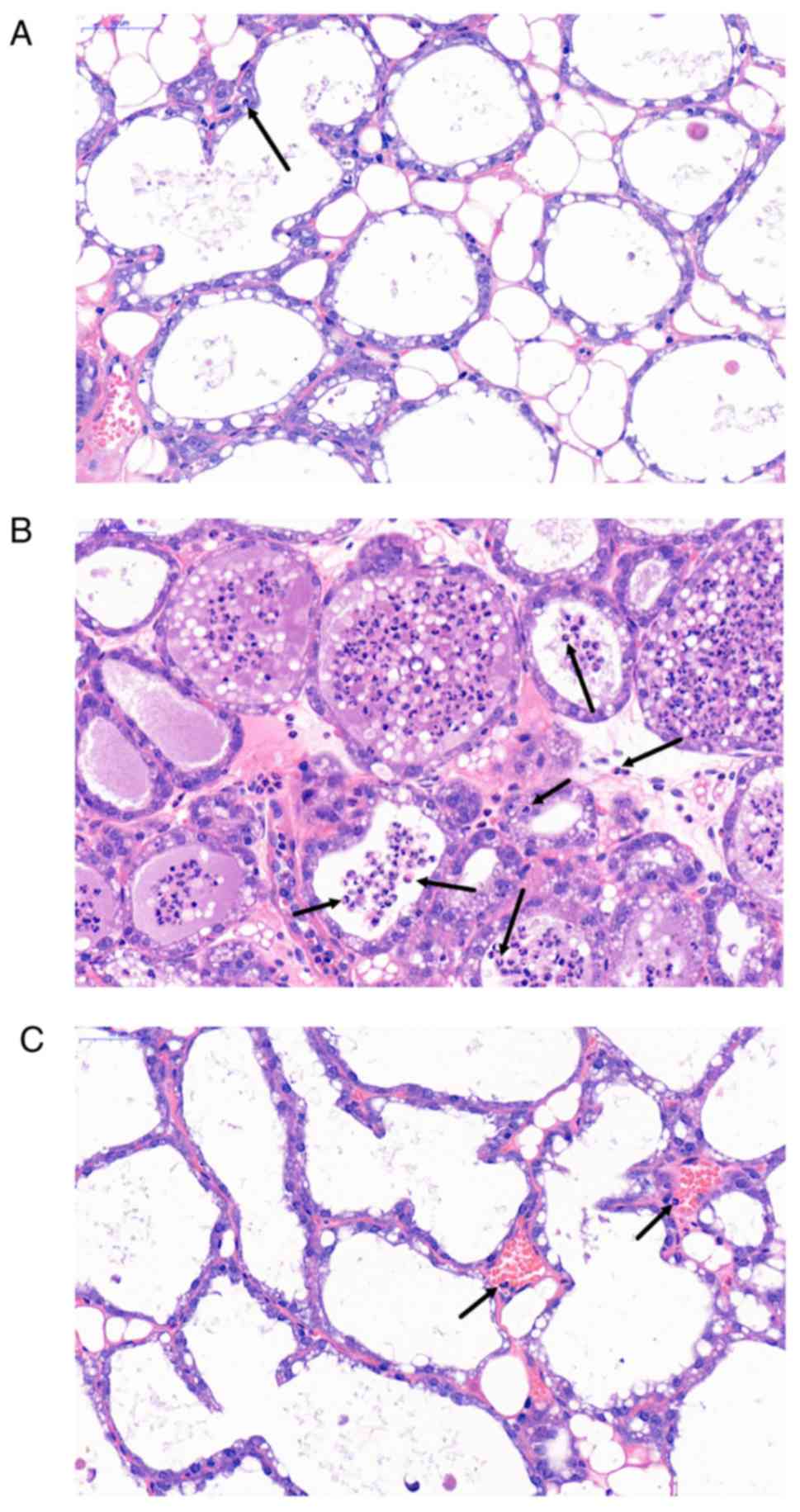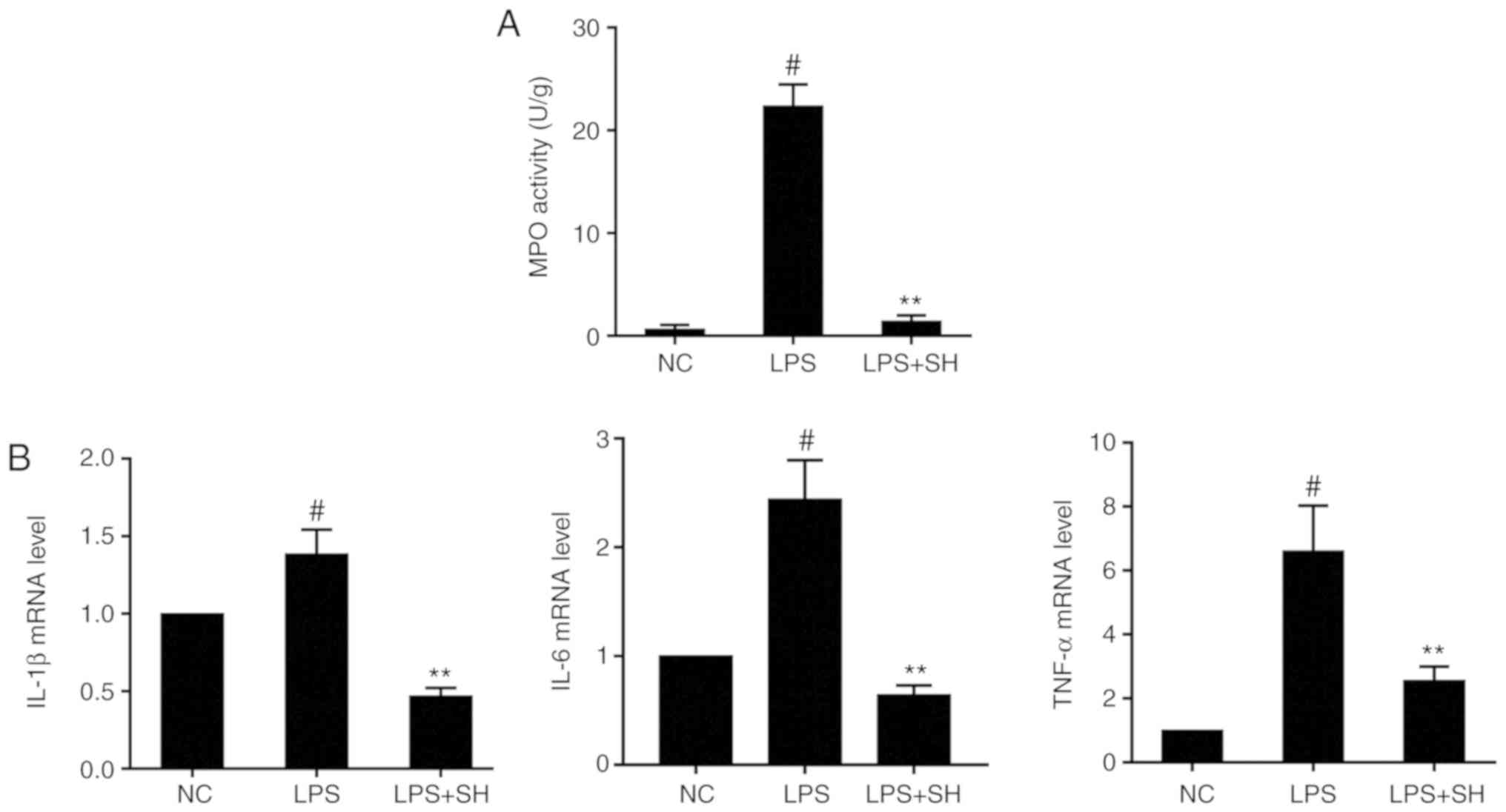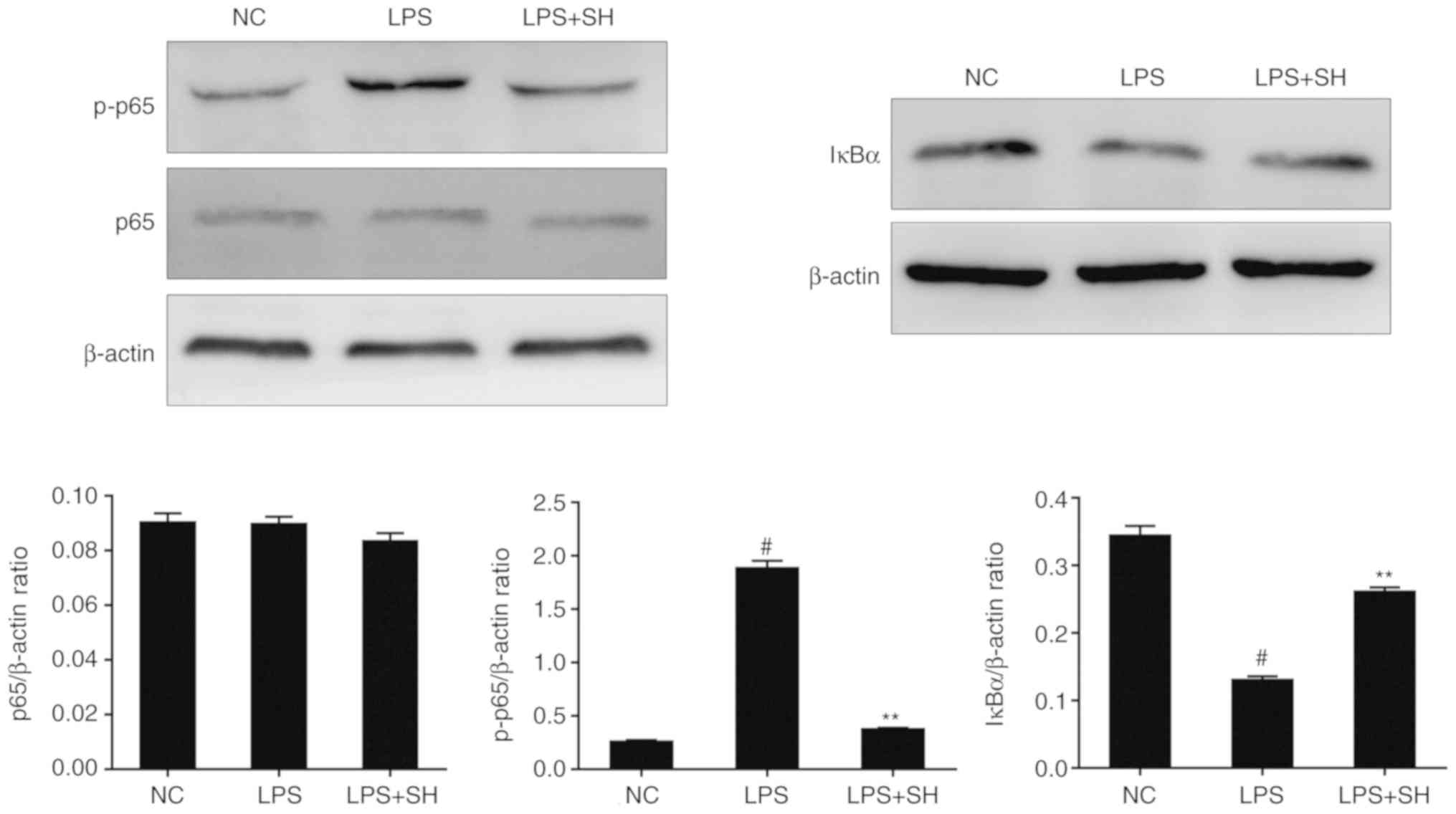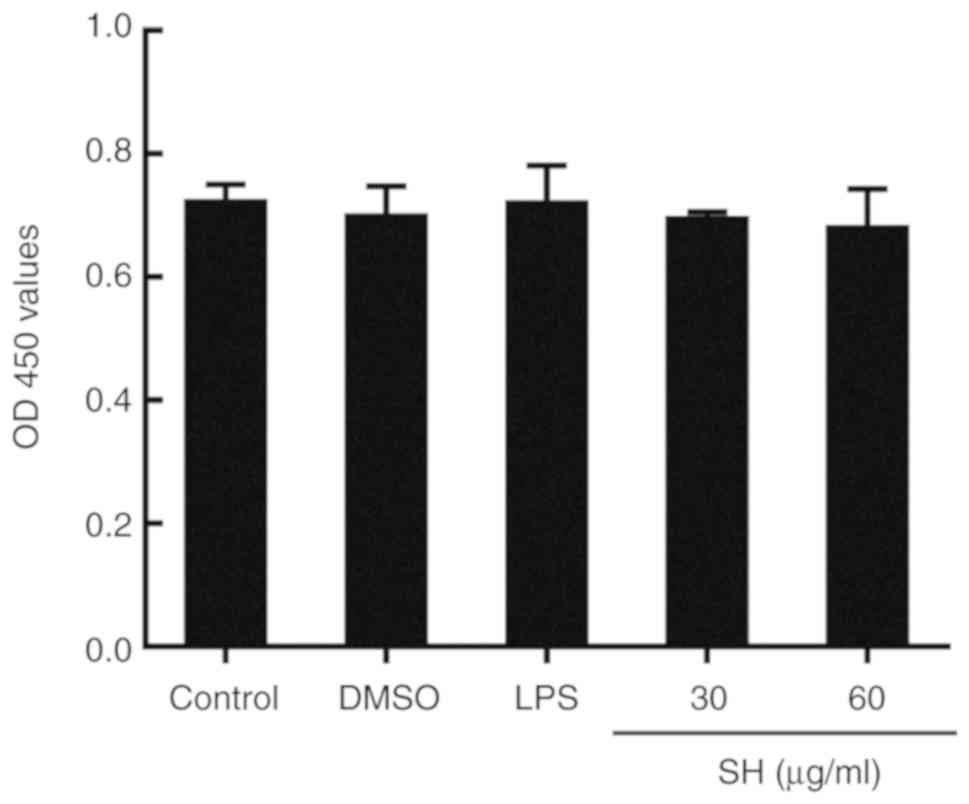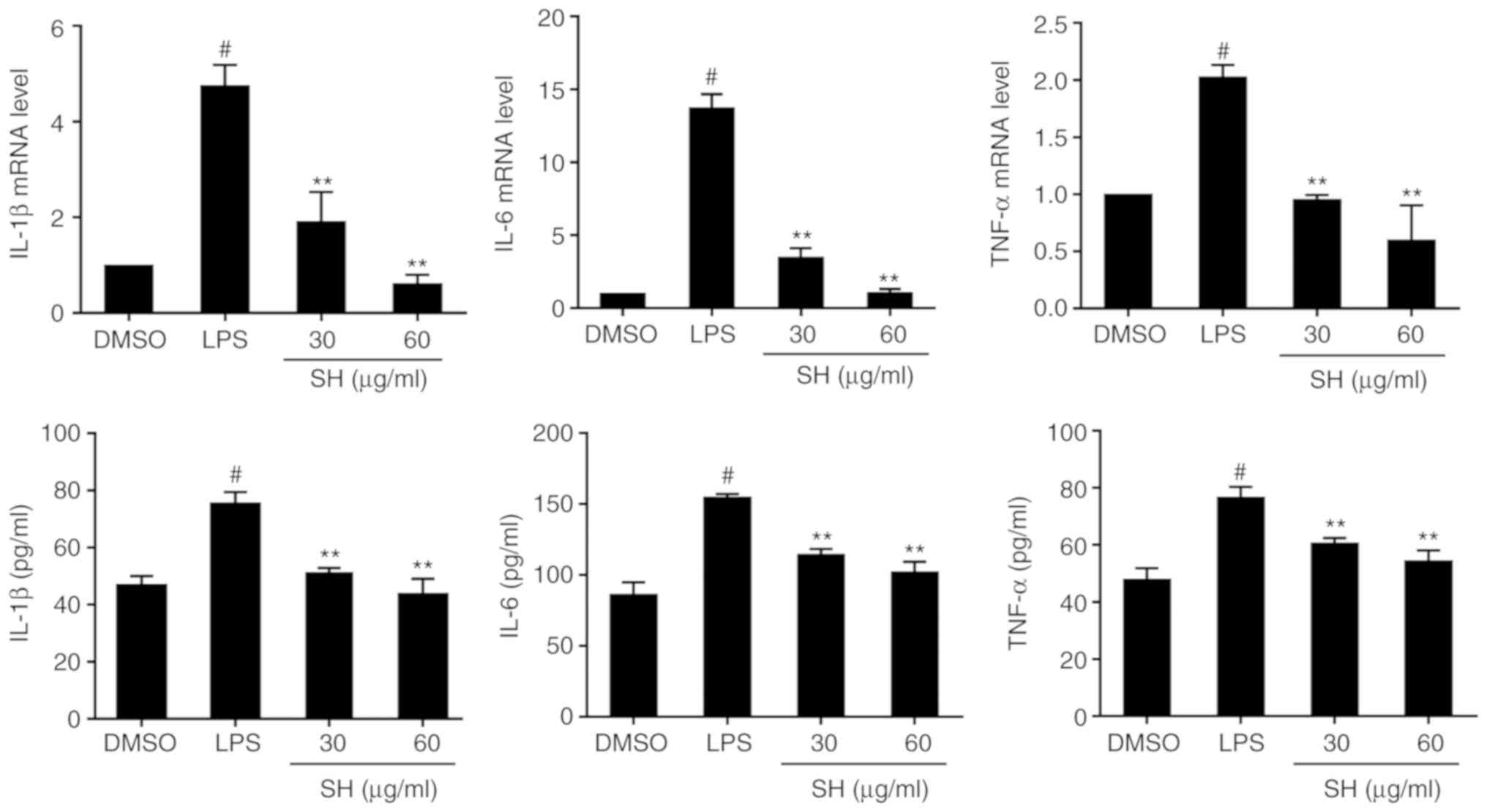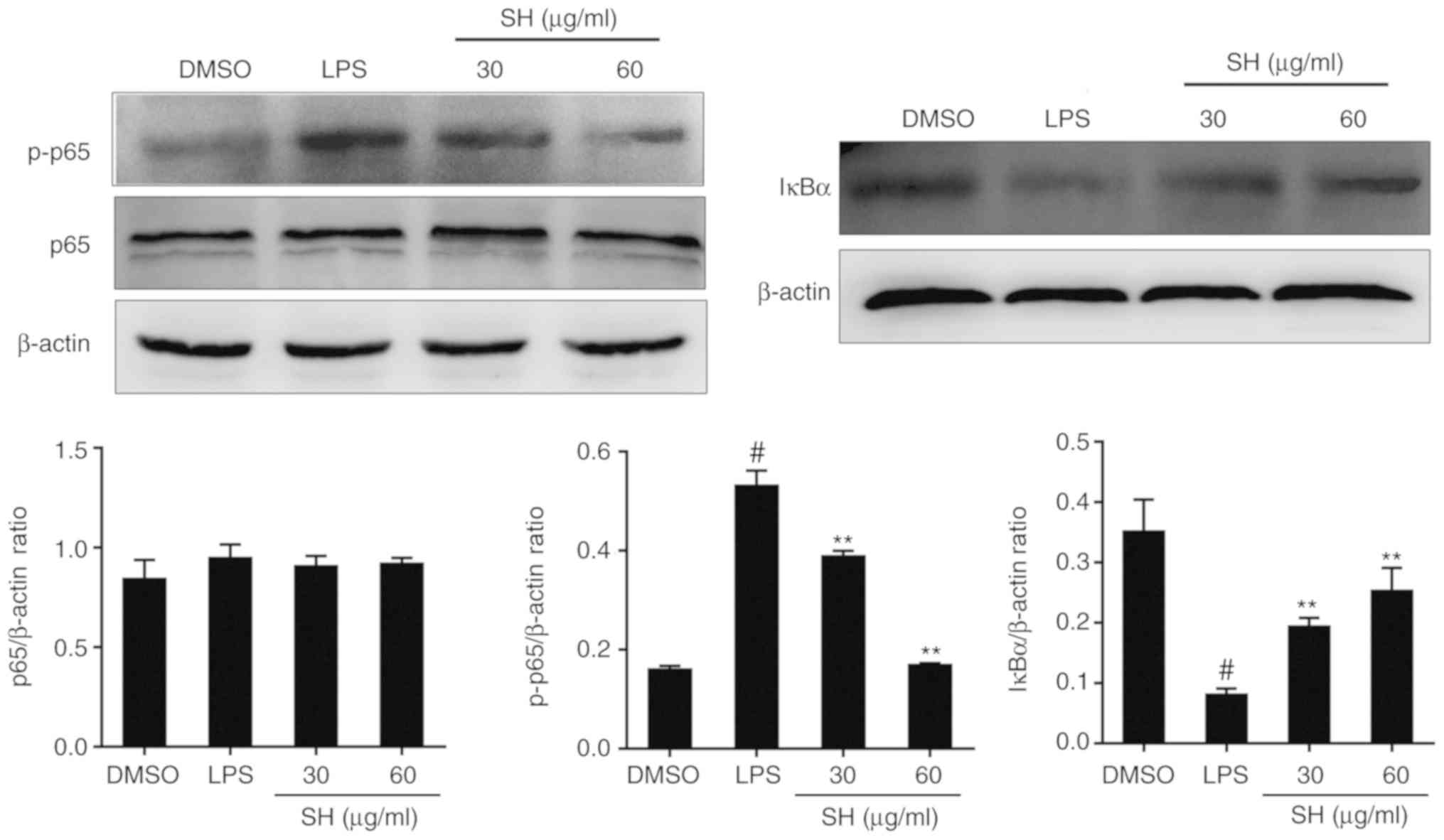Sodium houttuyfonate inhibits LPS‑induced mastitis in mice via the NF‑κB signalling pathway
- Authors:
- Published online on: January 10, 2019 https://doi.org/10.3892/mmr.2019.9846
- Pages: 2279-2286
Abstract
Introduction
Mastitis, a common disease in dairy herds, causes economic loss worldwide (1). A survey in 2007 showed that clinical mastitis results in an economic cost of 444 US dollars per average case in the USA, including direct costs of 128 dollars and indirect costs of 316 dollars (2). Previous research has confirmed that Escherichia coli is responsible for mastitis (3).
Lipopolysaccharide (LPS), also called endotoxin, is the main element of the outer membrane of Gram-negative bacteria, including Escherichia coli, and is a valuable tool for inducing inflammation, such as mastitis (4,5). LPS can stimulate Toll-like receptor 4 (TLR4), a member of the Toll-like receptor (TLR) family, which is known as one of the significant pathogen-recognition receptors (PRRs) (6). TLR4 signalling pathways then activate the Toll/interleukin-1 (IL-1) receptor (TIR) signalling pathway (7,8). Subsequently, myeloid differentiation primary response 88 (MyD88), a universal adaptor protein, responses to TIR first and activates IL-1 receptor-associated kinase 1 (IRAK1) and TNF receptor-associated factor 6 (TRAF6) (9). Then, phosphorylated IKKβ initiates the degradation of IκBα, which associates with a nuclear localization sequence to prevent the nuclear transfer of p65 (10). Then, NF-κB subunit p65 separates from IκB and is phosphorylated as pp65. Furthermore, it displaces into the nucleus and exhibits its DNA-binding activity, where NF-κB can trigger the release of various pro-inflammatory cytokines, such as interleukin (IL)-1β, IL-6 and tumor necrosis factor (TNF)α (11–13).
Many Chinese traditional herbs have attracted wide attention over the past decade due to their biological function (14). Sodium houttuyfonate (SH) (Fig. 1) is one of the main compounds in the volatile oil of Houttuynia cordata Thunb., which has been used as an anti-pyretic and detoxicated herbal medicine for the therapy of infections for an extensive period of time (15,16). The effects of SH on diabetic nephropathy and glomerulonephritis have been reported in experimental animals (17,18). Moreover, previous research suggests that SH inhibits LPS-induced inflammatory responses in bovine mammary epithelial cells (bMECs) by depressing the NF-κB signalling pathway (19). The authors investigated the levels of IL-1β, IL-6 and TNF-α by real-time quantitative PCR (RT-qPCR) and the expression of IκBα, NF-κB p65 and TLR4 by western blotting. All of the results showed that SH may be a potential agent for the therapy of mastitis.
Therefore, in order to verify whether SH causes the same effect in vivo, mouse models of LPS-induced mastitis were utilized in the present study. The mouse mastitis model is commonly used for the study of bovine intramammary infections as it closely mimics the inflammatory responses observed in natural mastitis (5,20,21). In addition, we also assayed the function of SH using a mouse mammary epithelial cell line.
Materials and methods
Reagents
Sodium houttuyfonate (SH) was purchased from Shanghai Yuanye Bio-Technology Co., Ltd. (Shanghai, China; purity ≥98%). LPS (Escherichia coli 055:B5) was provided by Sigma-Aldrich; Merck KGaA (Darmstadt, Germany). All of the antibodies used in this experiment were provided by Cell Signaling Technology (Beverly, MA, USA), including β-Actin (D6A8) Rabbit mAb (8457), NF-κB p65 (D14E12) XP® Rabbit mAb (8242), Phospho-NF-κB p65 (Ser468) Antibody (3039), IκBα (44D4) Rabbit mAb (4812) and Anti-rabbit IgG, HRP-linked Antibody (7074). Other chemicals were of reagent grade.
Animals
Twenty lactating female BALB/c mice (6-week old, 20–25 g) were purchased from the Wuhan Institute of Biological Products Co., Ltd. (Wuhan, China). Three mice were raised per cage with standard laboratory chow and ad libitum feeding. All of the mice were housed in the facilities at a temperature of 25±2°C with 50±2% humidity and a 12-h light/dark cycle for 1 week to adapt to the environment before the experiment. All of the animal experiments were performed according to the guidelines for the Laboratory Animal Research Center of Hubei Province and approved by the Ethics Committee on Animal Research of Huazhong Agricultural University (Wuhan, China).
Animal modelling and grouping
The mice were randomly assigned into three groups of six, namely, the negative control group (NC), the LPS group, and the LPS + SH (50 mg/kg, gastric perfusion) group. Mice were anaesthetized with ethyl ether using an anaesthesia machine. Mice in the NC group were given PBS, while mice in all other groups were infused with LPS using a 100-µl syringe into both the L4 (on the left) and R4 (on the right) abdominal mammary glands after the teats were disinfected with 75% alcohol (22). SH (at doses of 50 mg/kg, dissolved in DMSO and PBS) was administered 1 h before LPS injection by gastric perfusion in the LPS+SH group, and the mice in the control group were administered equal volumes of PBS. At 24 h after LPS injection, mice were sacrificed using cervical dislocation and the mammary tissues were harvested, one part of the sample was fixed into 4% paraformaldehyde, and the other part was stored at −80°C.
Histopathologic analysis
At 24 h after fixation in 4% paraformaldehyde, mammary tissues were embedded in paraffin and then the sections (4-µm) were stained with hematoxylin and eosin (H&E). Finally, pathological changes in the tissues were observed under a light microscope (Olympus Corporation, Tokyo, Japan) at ×400 magnification.
Myeloperoxidase (MPO) activity analysis
The levels of neutrophils and monocytes in mammary tissue were assessed using an MPO kit (Nanjing Jiancheng Bioengineering Institute, Nanjing, China). Mammary tissues (50 mg) were homogenized with reaction buffer (950 µl, w/v 1:19), and then the MPO activity was assayed according to the protocol of the kit.
Cell culture and treatment
The cells were cultured in 90% RPMI-1640 medium (Invitrogen; Thermo Fisher Scientific, Inc., Waltham, MA, USA) with 10% foetal bovine serum (FBS) at 37°C with 5% CO2 for incubation. The cells were divided into four groups: DMSO control (DMSO) group, LPS group, and SH treatment (30 and 60 µg/ml) groups. All of cells in the DMSO control group and the SH treatment groups were pretreated with DMSO and SH (30 and 60 µg/ml) for 1 h, respectively. Subsequently, the LPS group and the SH treatment groups were stimulated by LPS (1 µg/ml) for 1 h. The DMSO group was used as a negative control as the drug was diluted with DMSO.
Cell Counting Kit-8 (CCK-8) analysis
Cell proliferation status was assayed by a CCK-8 kit. The cells were seeded in 96-well plates at a density of 2,000 cells per well with 100 µl culture medium. After cultivation for 24 h, SH was added to each well to the final concentrations (30 and 60 µg/ml SH, n=6). Subsequently, the cells were cultured for another 24 h. Then, 10 µl of CCK-8 solution was added to the medium, and the culture was incubated for 1 h at 37°C with 5% CO2. The optical density (OD) values were read at 450 nm by a microplate reader (Bio-Rad Instruments, Hercules, CA, USA) (23).
ELISA analysis
The effects of SH on the levels of cytokines in cell supernatants were examined. IL-1β, IL-6 and TNF-α levels were measured with ELISA kits (Shanghai Hengyuan Biological Technology Co., Ltd, Shanghai, China) according to the manufacturer's instructions.
Reverse transcription-quantitative polymerase chain reaction (RT-qPCR)
Total RNA was extracted using TRIzol reagent (Invitrogen; Thermo Fisher Scientific, Inc., Waltham, MA, USA) from tissues and cells (1×106 cells/well) according to the manufacturer's instructions. The concentration and purity of the total RNA was measured using Q5000 (Quawell Technology Inc., San Jose, CA, USA) at a 260/280 nm ratio. Reverse transcription was performed immediately after measurement. qPCR was implemented using the LightCycler® 480 SYBR® Green I Master (Roche Diagnostics, Basel, Switzerland) and a PCR system (LightCycler® 96; Roche Diagnostics). The sequences of primers used in the study were designed with Primer Premier 5.0 (Premier, Canada), and the primers are shown in Table I. The relative quantitative assay was performed using the 2−ΔΔCq comparative method normalized by GAPDH (24).
Western blot analysis
Protein in tissues and cells were isolated by RIPA buffer (Biosharp, China) with 1 mM phenylmethylsulfonyl fluoride (PMSF) and phosphorylation of protease inhibitor cocktail. The concentrations of protein were tested using a BCA protein assay kit (Thermo Scientific). Total proteins (40 µg) were denatured by boiling for 10 min and were then separated by 10% SDS-PAGE. After transfer to polyvinylidene fluoride (PVDF) membranes and blocking in 5% non-fat dry milk for 2 h at room temperature, the proteins were incubated overnight (12 h) with primary antibodies (1:1,000 dilution) at 4°C. Then, the membranes were washed in TBST 3 times (10 min each time) and incubated with HRP-conjugated secondary antibody (1:4,000 dilution) for 1 h at room temperature. After washing as described above, immunoblot signals were measured with an enhanced chemiluminescence detection system (ImageQuant LAS 4000 mini; GE Healthcare, Chicago, IL, USA). Densitometry assays were completed using Image Pro Plus 6.0 software (Media Cybernetics, Inc., Rockville, MD, USA).
Statistical analysis
Statistical assays were performed using GraphPad Prism 7 software (GraphPad Software, Inc., La Jolla, CA, USA). All values are presented as the mean ± SEM. The significant differences between groups were analysed using one-way ANOVA with the Student's t-test. P<0.05 was considered to indicate a statistically significant difference. P-values are indicated as follows in the figures and legends: #P<0.05 vs. the control group; *P<0.05 vs. the LPS group; **P<0.01 vs. the LPS group.
Results
Effects of SH on pathological changes in the mouse mammary gland
The histopathological results are shown in Fig. 2. Compared with the NC group (Fig. 2A), the LPS group (Fig. 2B) exhibited significant mammary gland hyperaemia, mammary gland wall thickening and invasion of inflammatory cells such as neutrophils (as indicated by black arrows). However, SH (50 mg/kg; Fig. 2C) treatment obviously ameliorated these morphological changes in the mouse mammary gland tissues.
Effects of SH on MPO activity and the expression of inflammatory cytokines in vivo
MPO is most abundantly expressed in neutrophil granulocytes and can immediately reflect the levels of inflammation (25). The MPO assay showed that MPO activity in the LPS group was significantly increased when compared with that in the negative control (NC) group (P<0.05; Fig. 3A), while SH treatment decreased MPO activity relative to that in the LPS group, similar to the histopathology results. A previous study showed that LPS can markedly elevate the expression levels of inflammatory cytokines such as IL-1β, IL-6 and TNF-α (26). As shown in Fig. 3B, mRNA levels of cytokines in the LPS group were significantly higher than those in the NC group. SH also significantly downregulated the expression of these cytokines. These results suggested that SH may inhibit LPS-induced mastitis in mice.
Effects of SH on the NF-κB pathway in vivo
Phosphorylation of p65 plays a significant role in the activation of the NF-κB pathway (27). Phosphorylation and rapid degradation of IκBα is the sign of NF-κB-IκB complex changes (28). In this study, to clarify the function of SH on the NF-κB pathway, we detected the expression of IκBα and p65 protein in tissues by western blotting. As shown in Fig. 4, the phosphorylation of p65 protein was upregulated in the LPS group, while the levels of IκBα were downregulated. However, SH treatment suppressed the LPS-induced phosphorylation of p65 proteins and the degradation of IκBα, thus inhibiting the NF-κB pathway. These results demonstrated that SH ameliorates LPS-induced mastitis in mouse models through the NF-κB pathway.
Effects of SH on cell viability
Cell viability was measured using CCK-8 assay in this study. The results as shown in Fig. 5 demonstrated that SH (30 and 60 µg/ml) and DMSO (used as solvent) had no cytotoxicity on the mouse mammary epithelial cell line.
Effects of SH on the levels of inflammatory cytokines in vitro
To investigate the function of SH on cytokine levels, IL-1β, IL-6 and TNF-α production was detected by qPCR and ELISA. According to the results shown in Fig. 6, it was found that LPS stimulation promoted higher expression of cytokines than DMSO. Additionally, SH significantly decreased the expression of these cytokines.
Effects of SH on the NF-κB pathway in vitro
Related to the in vivo experiments, NF-κB pathway protein expression in cells was also verified. As shown in Fig. 7, the level of phosphorylated (p)-p65 was suppressed dose-dependently in the SH treatment groups, and the expression of IκBα was upregulated. In conclusion, SH depressed the NF-κB pathway by inhibiting the phosphorylation of p65 and the degradation of IκBα.
Discussion
Bovine mastitis leads to loss of milk production and extra treatment costs (29,30). Because mastitis is caused by various different pathogens, it is a challenge for many different countries (31). E. coli infection was suggested to be the most common cause of fatal mastitis (32). Lipopolysaccharide (LPS), a unique structure on the walls of Gram-negative bacteria, including E. coli, interacts with LPS-binding protein (LBP) and CD14 and further promotes the activation of TLR4 (33). TLR4 accelerates inflammatory gene expression via the NF-κB pathway (34). Sodium houttuyfonate (SH), first extracted from Houttuynia cordata Thunb. by Kosuge in 1952, is considered an anti-inflammatory medication for suppressing many bacteria, such as E. coli (35,36). Although the effects of SH on mastitis in bovine mammary epithelial cells have been elucidated (19), few studies have focused on the anti-inflammatory function of SH in animals. In the present study, we first investigated whether SH treatment ameliorates LPS-induced mastitis in mice
Histopathological examination of mammary glands showed that the changes in SH treatment groups were not as obvious as in the LPS group. The results indicate that SH has a protective effect on LPS-induced mastitis. In addition, MPO analysis and inflammatory cytokines assays also confirmed the protective effect of SH.
Some inflammatory cytokines, such as IL-1β, IL-6 and TNF-α, may cause tissue damage. As primary cytokines, IL-1β and TNF-α induce the secretion of IL-6, which plays an important role in the induction of acute disease (37). In the present study, the expression of IL-1β, IL-6 and TNF-α was substantially enhanced in LPS-induced mastitis. However, SH reduced the levels of these cytokines in vivo and in vitro. These results demonstrated that the anti-inflammatory activity of SH might be due to decreasing levels of inflammatory cytokines.
IκBα is associated with and tightly regulates the NF-κB complex (38). IκBα has been shown to have ankyrin repeats composing a 205-amino-acid internal region (39). Mutations of these ankyrin repeats can inhibit IκBα from interacting with NF-κB (40). Under normal conditions, IκBα preserves NF-κB in the cytoplasm by masking the nuclear localization sequences (41). When IKK initiates the sequence-specific phosphorylation and ubiquitination of IκBα, the result is the rapid degradation of IκB (42). Thus the present study detected the level of IκBα. In the LPS group, the expression of IκBα was obviously downregulated in vivo and in vitro, which can lead to the release of NF-κB p65 in the LPS group. However, SH treatment recovered the level of IκBα, which inhibits the activation of the NF-κB pathway.
In addition, the phosphorylation and nuclear translocation of p65 is generally regarded as a marker of initiation of the NF-κB pathway (27). With the degradation of IκB, NF-κB p65 is released from IκB molecules (43), and p65 is then free to translocate to the nucleus and bind to target genes to promote the expression of pro-inflammatory cytokines (44). In our study, we detected the expression of p65 and phosphorylated (p)-p65 protein using western blot analysis. Significantly, the expression of p-p65 protein was upregulated in the LPS group. In the in vivo study, SH had a marked effect on NF-κB pathway inhibition. In the in vitro study, SH reduced the p-p65 protein.
Based on the above experimental results, we can hypothesize that SH exhibits an anti-inflammatory function in LPS-induced mouse mastitis. Furthermore, the mechanisms underlying the effects of SH may be due to the inhibition of the NF-κB pathway, but the direct targets of SH and accurate molecular mechanisms warrant further investigation. All of these results suggest that SH is a potential therapeutic strategy for bovine mastitis.
Acknowledgements
Not applicable.
Funding
This study was sponsored by the National Natural Science Foundation of China (no. 31772816).
Availability of data and materials
The datasets used and/or analysed during the current study are available from the corresponding author upon reasonable request.
Authors' contributions
GD conceived and designed the research. PL and CY acquired data, analysed and interpreted data and performed statistical analysis. PL was responsible for manuscript writing and contributed to animal experiment with CY. CY and GZ contributed to most of the experimental designs and operations. SL contributed to interpretation of the data, manuscript review and editing. TZ and SG performed qPCR. KJ and HW gave technical guidance on western blotting and contributed to analysis of its results. TZ, SG, KJ and HW revised the manuscript for important intellectual content. CQ and MG contributed to data analysis. All authors read and approved the final manuscript and agree to be accountable for all aspects of the work in ensuring that questions related to the accuracy or integrity of any part of the work are appropriately investigated and resolved.
Ethics approval and consent to participate
All of the animal experiments were performed according to the guidelines for the Laboratory Animal Research Center of Hubei Province and approved by the Ethics Committee on Animal Research of Huazhong Agricultural University (Wuhan, Hubei, China).
Patient consent for publication
Not applicable.
Competing interest
The authors declare that they have no competing interests.
Glossary
Abbreviations
Abbreviations:
|
SH |
sodium houttuyfonate |
|
bMECs |
bovine mammary epithelial cells |
|
CCK-8 |
Cell Counting Kit-8 |
|
LPS |
lipopolysaccharide |
References
|
Le M, aréchal C, Thiéry R, Vautor E and Le Loir Y: Mastitis impact on technological properties of milk and quality of milk products-a review. Dairy Sci Technol. 91:247–282. 2011. View Article : Google Scholar | |
|
Rollin E, Dhuyvetter KC and Overton MW: The cost of clinical mastitis in the first 30 days of lactation: An economic modeling tool. Prev Vet Med. 122:257–264. 2015. View Article : Google Scholar : PubMed/NCBI | |
|
Halasa T, Nielen M, Huirne RBM and Hogeveen H: Stochastic bio-economic model of bovine intramammary infection. Livestock Sci. 124:295–305. 2009. View Article : Google Scholar | |
|
Kauf AC, Vinyard BT and Bannerman DD: Effect of intramammary infusion of bacterial lipopolysaccharide on experimentally induced Staphylococcus aureus intramammary infection. Res Vet Sci. 82:39–46. 2007. View Article : Google Scholar : PubMed/NCBI | |
|
Lee JW, Paape MJ, Elsasser TH and Zhao X: Elevated Milk soluble CD14 in bovine mammary glands challenged with Escherichia coli lipopolysaccharide. J Dairy Sci. 86:2382–2389. 2003. View Article : Google Scholar : PubMed/NCBI | |
|
Zeuke S, Ulmer AJ, Kusumoto S, Katus HA and Heine H: TLR4-mediated inflammatory activation of human coronary artery endothelial cells by LPS. Cardiovasc Res. 56:126–134. 2002. View Article : Google Scholar : PubMed/NCBI | |
|
Takeuchi O, Kaufmann A, Grote K, Kawai T, Hoshino K, Morr M, Mühlradt PF and Akira S: Cutting edge: Preferentially the R-stereoisomer of the mycoplasmal lipopeptide macrophage-activating lipopeptide-2 activates immune cells through a toll-like receptor 2- and MyD88-dependent signaling pathway. J Immunol. 164:554–557. 2000. View Article : Google Scholar : PubMed/NCBI | |
|
Burns K, Martinon F, Esslinger C, Pahl H, Schneider P, Bodmer JL, Di Marco F, French L and Tschopp J: MyD88, an adapter protein involved in interleukin-1 signaling. J Biol Chem. 273:12203–12209. 1998. View Article : Google Scholar : PubMed/NCBI | |
|
Arancibia SA, Beltrán CJ, Aguirre IM, Silva P, Peralta AL, Malinarich F and Hermoso MA: Toll-like receptors are key participants in innate immune responses. Biol Res. 40:97–102. 2007. View Article : Google Scholar : PubMed/NCBI | |
|
Beg AA, Ruben SM, Scheinman RI, Haskill S, Rosen CA and Baldwin AS: I kappa B interacts with the nuclear localization sequences of the subunits of NF-kappa B: A mechanism for cytoplasmic retention. Genes Dev. 6:1899–1913. 1992. View Article : Google Scholar : PubMed/NCBI | |
|
Ruifeng G, Yunhe F, Zhengkai W, Ershun Z, Yimeng L, Minjun Y, Xiaojing S, Zhengtao Y and Naisheng Z: Chlorogenic acid attenuates lipopolysaccharide-induced mice mastitis by suppressing TLR4-mediated NF-κB signaling pathway. Eur J Pharmacol. 729:54–58. 2014. View Article : Google Scholar : PubMed/NCBI | |
|
Triantafilou M and Triantafilou K: The dynamics of LPS recognition: Complex orchestration of multiple receptors. J Endotoxin Res. 11:5–11. 2005. View Article : Google Scholar : PubMed/NCBI | |
|
Zhang X, Wang Y, Xiao C, Wei Z, Wang J, Yang Z and Fu Y: Resveratrol inhibits LPS-induced mice mastitis through attenuating the MAPK and NF-κB signaling pathway. Microb Pathog. 107:462–467. 2017. View Article : Google Scholar : PubMed/NCBI | |
|
Al-Sheraji SH, Ismail A, Manap MY, Mustafa S, Yusof RM and Hassan FA: Prebiotics as functional foods: A review. J Functional Foods. 5:1542–1553. 2013. View Article : Google Scholar | |
|
Wang D, Noda Y, Zhou Y, Nitta A, Nabeshima T and Yu Q: Effects of sodium houttuyfonate on phosphorylation of CaMK II CREB and ERK 1/2 and expression of c-Fos in macrophages. Int Immunopharmacol. 4:1083–1088. 2004. View Article : Google Scholar : PubMed/NCBI | |
|
Wu Z, Tan B, Zhang H, Guo Y, Tu Y, Qiu F and Yang A: Effects of sodium houttuyfonate on pulmonary inflammation in COPD model rats. Inflammation. 40:2109–2117. 2017. View Article : Google Scholar : PubMed/NCBI | |
|
Lan S, Hai YQ, Huang Q, Sinica A and Shengyang: The effect of Houttuyninum on cellar immunoiogic function in splenectomy animals. Chin Pharmacol Bulletin. 17:51–54. 2001. | |
|
Pan P, Wang YJ, Han L, Liu X, Zhao M and Yuan YF: Effects of sodium houttuyfonate on expression of NF-κB and MCP-1 in membranous glomerulonephritis. J Ethnopharmacol. 131:203–209. 2010. View Article : Google Scholar : PubMed/NCBI | |
|
Wang W, Hu X, Peng S, Zhang N and Fu Y: Sodium houttuyfonate inhibits LPS-induced inflammatory response via suppressing TLR4/NF-κB signaling pathway in bovine mammary epithelial cells. Microb Pathog. 107:12–16. 2017. View Article : Google Scholar : PubMed/NCBI | |
|
Zheng J, Watson AD and Kerr DE: Genome-wide expression analysis of lipopolysaccharide-induced mastitis in a mouse model. Infect Immun. 74:1907–1915. 2006. View Article : Google Scholar : PubMed/NCBI | |
|
Notebaert S and Meyer E: Mouse models to study the pathogenesis and control of bovine mastitis. A review. Vet Q. 28:2–13. 2006. View Article : Google Scholar : PubMed/NCBI | |
|
Li D, Zhang N, Cao Y, Zhang W, Su G, Sun Y, Liu Z, Li F, Liang D, Liu B, et al: Emodin ameliorates lipopolysaccharide-induced mastitis in mice by inhibiting activation of NF-κB and MAPKs signal pathways. Eur J Pharmacol. 705:79–85. 2013. View Article : Google Scholar : PubMed/NCBI | |
|
Li Z, Shen J, Wu WK, Yu X, Liang J, Qiu G and Liu J: Leptin induces cyclin D1 expression and proliferation of human nucleus pulposus cells via JAK/STAT, PI3K/Akt and MEK/ERK pathways. PLoS One. 7:e531762012. View Article : Google Scholar : PubMed/NCBI | |
|
Livak KJ and Schmittgen TD: Analysis of relative gene expression data using real-time quantitative PCR and the 2(-Delta Delta C(T)) method. Methods. 25:402–408. 2001. View Article : Google Scholar : PubMed/NCBI | |
|
Klebanoff SJ: Myeloperoxidase: Friend and foe. J Leukoc Biol. 77:598–625. 2005. View Article : Google Scholar : PubMed/NCBI | |
|
Vels L, Røntved CM, Bjerring M and Ingvartsen KL: Cytokine and acute phase protein gene expression in repeated liver biopsies of dairy cows with a lipopolysaccharide-induced mastitis. J Dairy Sci. 92:922–934. 2009. View Article : Google Scholar : PubMed/NCBI | |
|
Neumann M, Grieshammer T, Chuvpilo S, Kneitz B, Lohoff M, Schimpl A, Franza BR Jr and Serfling E: RelA/p65 is a molecular target for the immunosuppressive action of protein kinase A. EMBO J. 14:1991–2004. 1995. View Article : Google Scholar : PubMed/NCBI | |
|
Hiscott J, Marois J, Garoufalis J, D'Addario M, Roulston A, Kwan I, Pepin N, Lacoste J, Nguyen H, Bensi G, et al: Characterization of a functional NF-kappa B site in the human interleukin 1 beta promoter: Evidence for a positive autoregulatory loop. Mol Cell Biol. 13:6231–6240. 1993. View Article : Google Scholar : PubMed/NCBI | |
|
Miller GY, Bartlett PC, Lance SE, Anderson J and Heider LE: Costs of clinical mastitis and mastitis prevention in dairy herds. J Am Vet Med Assoc. 202:1230–1336. 1993.PubMed/NCBI | |
|
Wilson DJ, González RN, Hertl J, Schulte HF, Bennett GJ, Schukken YH and Gröhn YT: Effect of clinical mastitis on the lactation curve: A mixed model estimation using daily milk weights. J Dairy Sci. 87:2073–2084. 2004. View Article : Google Scholar : PubMed/NCBI | |
|
Gröhn YT, Wilson DJ, González RN, Hertl JA, Schulte H, Bennett G and Schukken YH: Effect of pathogen-specific clinical mastitis on milk yield in dairy cows. J Dairy Sci. 87:3358–3374. 2004. View Article : Google Scholar : PubMed/NCBI | |
|
Menzies FD, Bryson DG, Mccallion T and Matthews DI: A study of mortality among suckler and dairy cows in Northern ireland in 1992. Vet Rec. 137:531–536. 1995. View Article : Google Scholar : PubMed/NCBI | |
|
Burvenich C, Van MV, Mehrzad J, Diez-Fraile A and Duchateau L: Severity of E. coli mastitis is mainly determined by cow factors. Vet Res. 34:521–564. 2003. View Article : Google Scholar : PubMed/NCBI | |
|
Akira S: Toll-like receptors and innate immunity. Adv Immunol. 388:621–625. 2009. | |
|
Ye X, Li X, Yuan L, Ge L, Zhang B and Zhou S: Interaction of houttuyfonate homologues with the cell membrane of gram-positive and gram-negative bacteria. Colloids Surf A Physicochemical Eng Aspects. 301:412–418. 2007. View Article : Google Scholar | |
|
Kosuge T: Structure of an antimicrobial substance isolated from Houttuynia cordata thunb. J Pharmaceutical Soc Japan. 72:1227–1231. 1952. View Article : Google Scholar | |
|
Xing Z, Gauldie J, Cox G, Baumann H, Jordana M, Lei XF and Achong MK: IL-6 is an antiinflammatory cytokine required for controlling local or systemic acute inflammatory responses. J Clin Invest. 101:311–320. 1998. View Article : Google Scholar : PubMed/NCBI | |
|
Huxford T, Huang DB, Malek S and Ghosh G: The crystal structure of the IkappaBalpha/NF-kappaB complex reveals mechanisms of NF-kappaB Inactivation. Cell. 95:759–770. 1998. View Article : Google Scholar : PubMed/NCBI | |
|
Baldwin AS Jr: THE NF-kappaB and I kappa B proteins: New discoveries and insights. Ann Rev Immunol. 14:649–683. 1996. View Article : Google Scholar | |
|
Siebenlist U, Franzoso G and Brown K: Structure, regulation and function of NF-kappa B. Ann Rev Cell Biol. 10:405–455. 1994. View Article : Google Scholar : PubMed/NCBI | |
|
Chae SW: Function and activation of NF-kappa B in immune system. J Cell Biol. 33:307–318. 2005. | |
|
Scherer DC, Brockman JA, Chen Z, Maniatis T and Ballard DW: Signal-induced degradation of I kappa B alpha requires site-specific ubiquitination. Proc Natl Acad Sci USA. 92:11259–11263. 1995. View Article : Google Scholar : PubMed/NCBI | |
|
Hoesel B and Schmid JA: The complexity of NF-κB signaling in inflammation and cancer. Mol Cancer. 12:862013. View Article : Google Scholar : PubMed/NCBI | |
|
Mercurio F and Manning AM: Multiple signals converging on NF-kappaB. Curr Opin Cell Biol. 11:226–232. 1999. View Article : Google Scholar : PubMed/NCBI |




